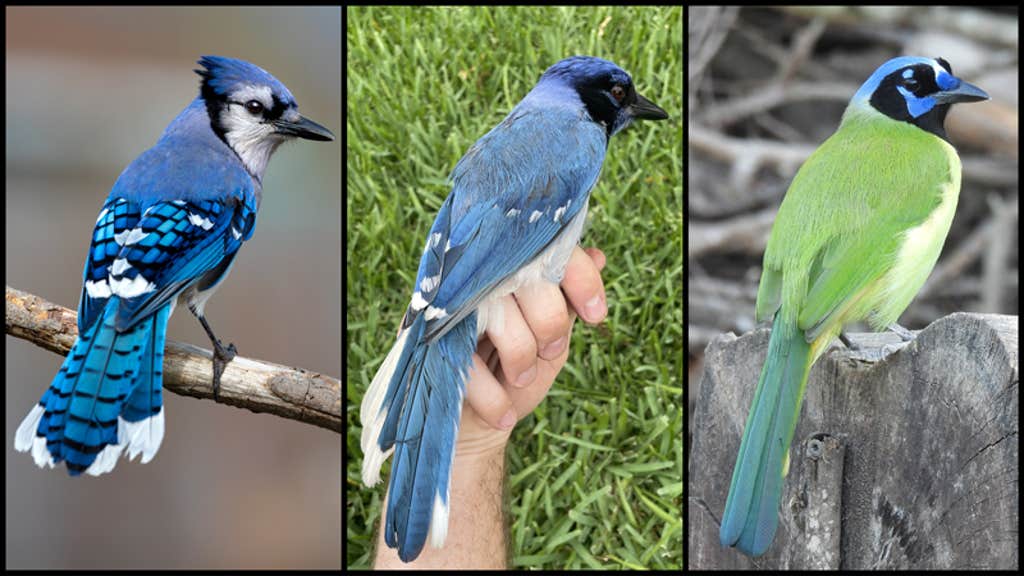Hybrid species have long sparked the human imagination: lion-tigers, zebra-horses, minotaurs. Now, we have a brand new chimera to marvel at: the “grue jay,” a dazzling bird that is half-blue jay, half-green jay. It is a harbinger of our future under climate change.
Graduate student Brian Stokes discovered the grue jay while completing his doctoral studies at the University of Texas. He was tracking the tropical-dwelling green jay, whose range had shifted nearly 124 miles northward over the previous few decades, due to climate change. One day, while monitoring Facebook birding posts about the green jays, he noticed that a birder named Donna had posted a mysterious picture.
“She posted this weird looking bird and was asking what it was,” Stokes recalls. “She had thought it was maybe a blue jay that had, like, some sort of genetic mutation or something like that.”

Stokes and his advisor, ecologist Tim Keitt, traveled to the woman’s house, near San Antonio, and captured the strange-looking bird with a mist net in 2023. They noted that the bird was hanging out with blue jays and making their calls—but also the vocalizations associated with green jays. They drew blood for analysis, attached a metal leg band, and let the animal go. Back in the lab, the DNA analysis showed the hybrid bird had a green jay mother and a blue jay father, the first time such a thing had been observed in non-captive populations. The findings were published earlier this month in the journal Ecology and Evolution.
Hybrid species are surprisingly common in the plant kingdom, but less so among animals, with around 10 to 15 percent of bird species known to hybridize. But as the ranges of animals shift due to changes in global climate, the likelihood of encounters between species that have never interacted before increases, which may lead to new ecological communities. “It’s an interesting sign of what is potentially to come in climate change and biodiversity shifts,” Stokes says.
Just because two species come into contact doesn’t necessarily mean they are going to make babies together. Stokes was surprised that the different jays mated at all, because both species hang out in small groups, and are fairly territorial and aggressive. “We had assumed they would be really antagonistic to one another,” he says, “so we really were very surprised to see this happen.” So far, only the one hybrid grue jay has been observed.
“She posted this weird looking bird and was asking what it was.”
Scientists have documented other climate-linked hybrids in the wild, like the pizzly bear—where grizzly and polar bear meet, and narlugas, the offspring of narwhals and belugas. There are also other instances where the ranges of distinct species have begun to overlap due to changing temperatures: The southern flying squirrel and the northern flying squirrel or the black-capped and Carolina chickadees.
“We expect that climate will shift species ranges leading to hybridization,” says Scott Taylor, a biologist at the University of Colorado who was not involved in the grue jay study. “We’re seeing this across the globe.” Of course, many hybrids are sterile, so they don’t create new species.
Taylor says the grue jay hybrid is a really interesting finding. “It is always startling to find a new kind of hybrid bird and very cool in this case that it is between a subtropical and a temperate species,” he says. He cautions, though, that it’s not a new species because it’s likely infertile and also reproductively isolated from other hybrids. That means the new bird may have little to no influence on the future evolution of either blue jays or green jays. “We need time to know,” he says.
David Toews, a biologist at Pennsylvania State University who has previously described other new hybrid birds, says climate-induced hybridization is just one of many hazards that birds in the wild face. “While I do think in some instances it could be significant, most species face a multitude of other threats—most importantly, habitat loss. Hybridization seems pretty far down the list for many species,” he says. “For instance, hybridization between spotted owls and barred owls is an issue for the endangered spotted owl; however, the main driver of its conservation concern has been significant habitat loss and modification.”
For Stokes, the discovery of the strange-looking bird on Facebook was, if nothing else, fun and weird. “It’s just two really charismatic species and a funky little bird in the end.” ![]()
More from Nautilus about hybrid animals:
“A Strange New Gene Pool of Animals Is Brewing in the Arctic” Scientist have seen the future and it is “grolar bears”
“New Bird Species Arises From Hybrids, as Scientists Watch” The rapid, unorthodox emergence of a new finch in the Galápagos hints that speciation isn’t rare. New hybrid species may quietly appear and disappear without anyone noticing.
“It’s Time to Make Chimp-Human Hybrids” The humanzee is both scientifically possible and morally defensible
Enjoying Nautilus? Subscribe to our free newsletter.
Lead image: Brian Stokes
































